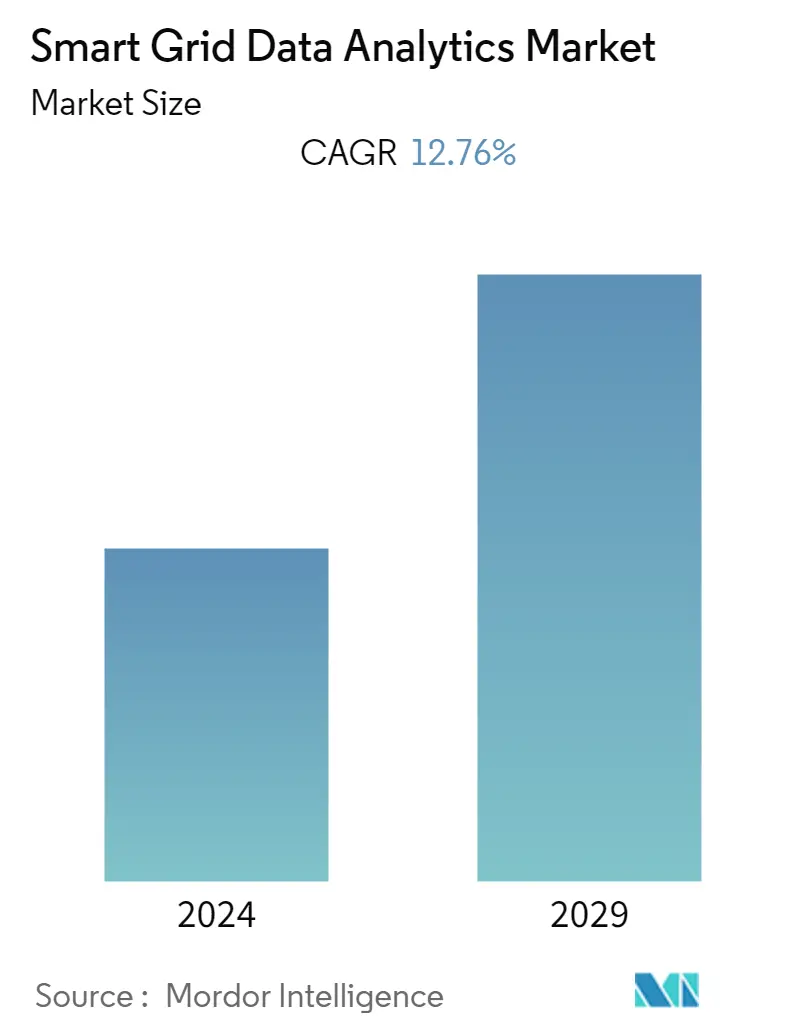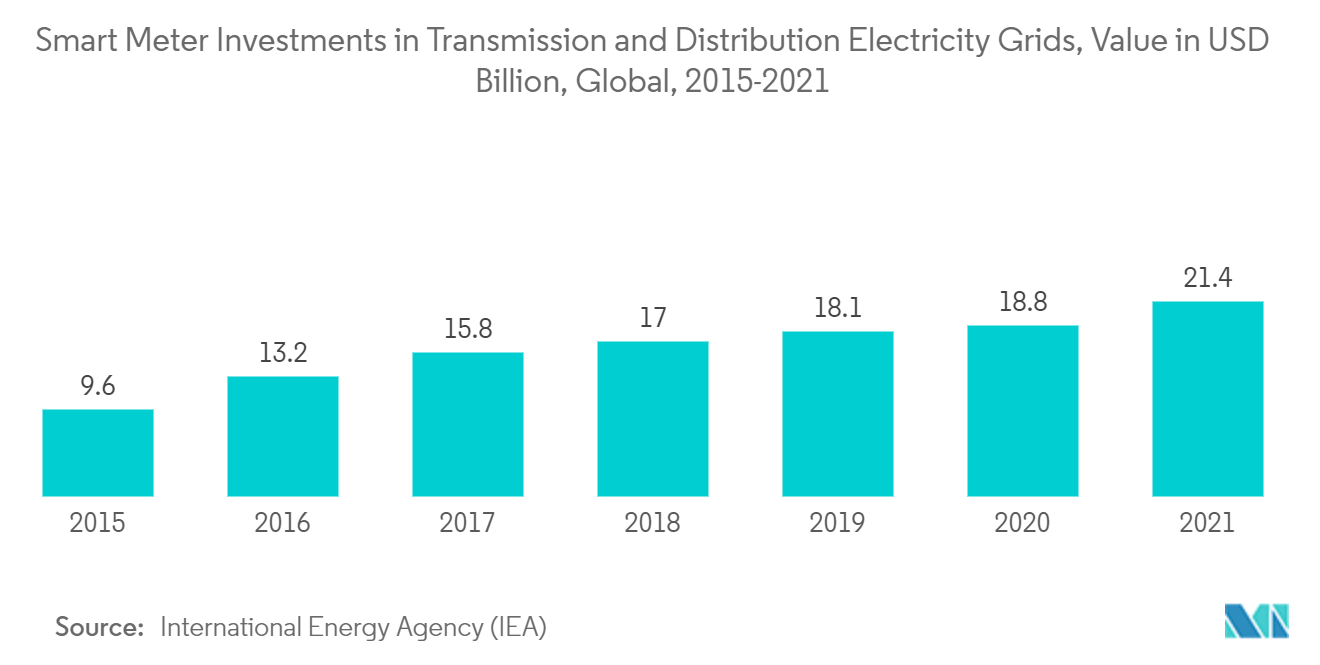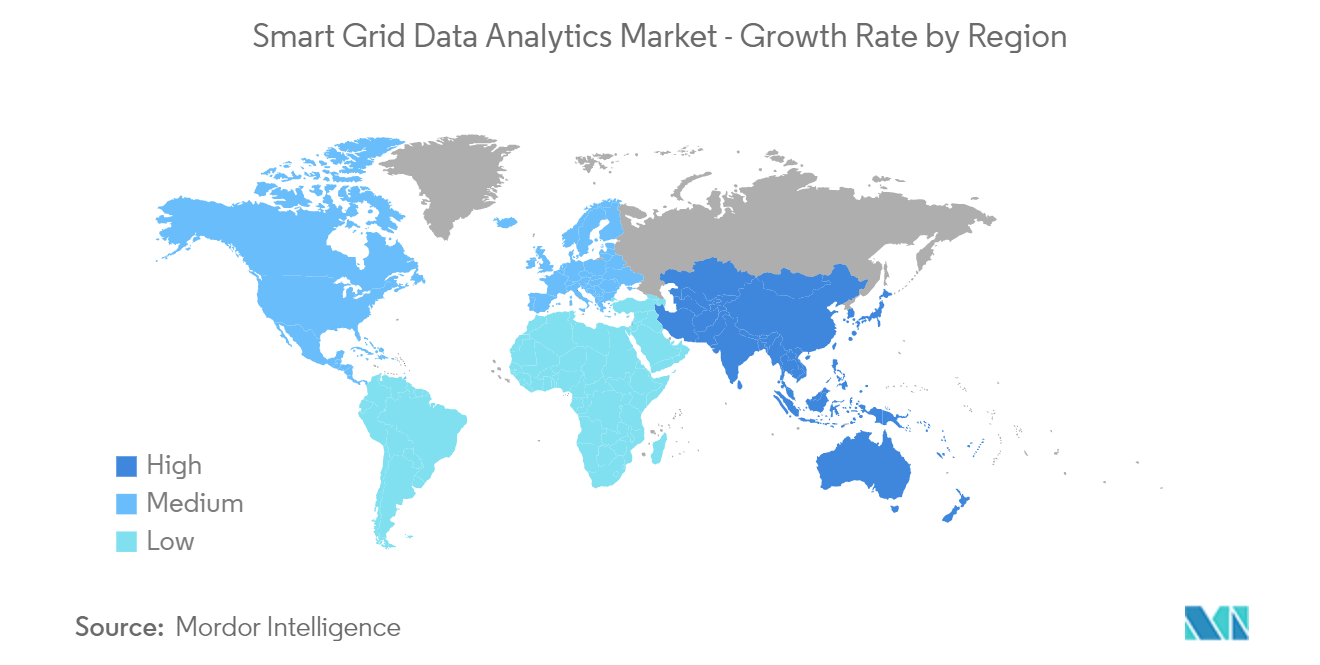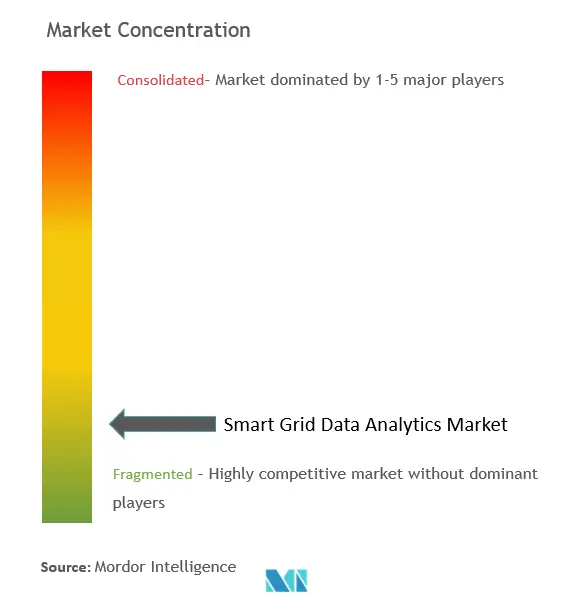Smart Grid Data Analytics Market Size

| Study Period | 2019 - 2029 |
| Base Year For Estimation | 2023 |
| CAGR | 12.76 % |
| Fastest Growing Market | Asia-Pacific |
| Largest Market | North America |
| Market Concentration | Low |
Major Players
*Disclaimer: Major Players sorted in no particular order |
Smart Grid Data Analytics Market Analysis
During the time frame of the forecast, the smart grid data analytics market is expected to register a CAGR of 12.76%. The smart grid data analytics market is expected to develop at a faster rate during the projected period due to increased investment in smart grid initiatives. With the introduction of modern technologies such as IoT, players have been focusing on integrating smart grid solutions in a more significant way. Due to the continuing trend in data creation, power utility businesses are merging big data with billions more rows of new IoT and smart sensor data. Smart meter data can assist in more efficiently segmenting customers by providing a better understanding of their behavior.
- A big need for a smart grid data analytics market is likely to come from the growing need for electricity. According to the International Energy Agency (IEA), the world's electricity demand will rise by 5,900 terawatt-hours (TWh) in the Stated Policies Scenario (STEPS) and by over 7,000 TWh in the Announced Pledges Scenario (APS) by 2030. This is the same as adding the current demand in the United States and the European Union.
- Moreover, organizations plan to invest in the expansion, modernization, and decentralization of the electricity infrastructure for improved resiliency. The infrastructure of the power grid has been getting more digitalized and connected over time, making it possible for important digital communications to flow reliably and safely. Across the Indian subcontinent, there have also been the beginnings of a number of projects that will help people with their electricity problems.
- An enormous influx of data has been driving market growth. According to the IEEE, to enable being smart, a massive amount of data has been exchanged between grid components and the enterprise systems that manage these components. Based on the application, the information exchanged helps economically optimize the bidirectional power flow between a utility and its customers.
- Furthermore, smart grids collect much more data than the manual energy meter reading system. This permits the use of data analysis techniques and the preparation of highly realistic consumption forecasts, as many more variables are taken into account. Therefore, the opportunities for smart grid analytics have been expanding because there has been an exponential increase in the amount of data available in order to develop analytical models.
- However, the high costs of smart grid systems and the need for more skilled professionals have been restraining the market's growth. The most prominent limitation of smart metering is the availability of capital funding. Smart systems are comparatively more expensive than the standard metering equipment that most service providers and users employ. Furthermore, different smart meters have been designed with various parameters based on operational and consumer requirements, inhibiting the use of complicated equipment that needs skilled labor for handling and installation.
- The COVID-19 epidemic hurt the world economy because it hurt a lot of businesses, especially in the electricity sector, and stopped work in a lot of other sectors. After COVID-19 broke out, the price of electricity went down, which hurt a lot of companies in the energy and power industries. Additionally, according to the US Department of Homeland Security (DHS), the utility sector was one of the 16 essential infrastructure sectors that the COVID-19 epidemic severely impacted.
Smart Grid Data Analytics Market Trends
Growing Investments in Smart Grid Projects
- The global smart metering analytics market is expected to grow because more money is being spent on smart grids and more renewable energy sources are being added to existing grids. Also, R&D is being updated more in developed economies, which should help the market grow.
- For instance, according to the IEA, in 2021, investments in smart meters in transmission and distribution electricity grids were valued at around USD 21.4 billion, a 13.8% rise in investments compared to the previous year, 2020. Such a significant rise in investments may indicate the growing need for digital infrastructure, thereby providing substantial profits to the vendors operating in the market.
- The rate of installations in the residential, commercial, and industrial sectors has been going up because of how the government framework and policies are always changing.Several emerging nations, including China and the United States, have witnessed a high-scale deployment of smart meters, mainly due to the continuous support of their respective governments. The factors above are expected to drive the demand for analytic solutions to handle the vast data from these smart meters.
- Smart meters are being used more and more by private utility companies in the United States, like ConEd and Duke.This is evident by the fact that, with smart meters deployed by utilities in the United States, about 111 million advanced (smart) metering infrastructure (AMI) installations were made in 2021, accounting for over 69% of all electric meter installations.
Additionally, the government of India's national initiative for smart meters (SMNP) intends to replace 250 million outdated meters with new ones in June 2022. It would improve the effectiveness of energy consumption and monitoring and enhance discoms' yearly income. This may result in the generation of more data per year. In 2022, China announced plans to increase investment, with the State Grid Corporation of China budgeting for more than CNY 500 billion and concentrating on ultra-high-voltage projects, upgrading the distribution network, and increasing levels of digitalization of its grids. Owing to these factors, the market studied is expected to witness growth during the forecast period.

Asia-Pacific to Witness the Significant Growth Rates
- Two highly populated nations, namely India and China, significantly dominate the Asia-Pacific region.Rising populations in places like China, Japan, and India have increased the demand for residential infrastructure and electricity use. This has increased the demand for electricity in countries that support the use of smart grids, which may create a market for smart grid data analytics.
- The growth of smart cities is anticipated to increase the region's market competencies. South Korea announced plans to invest USD 350 million in around 300 companies to help develop an IoT ecosystem within the country. A pilot is being launched in a town southeast of Seoul, in partnership with Samsung Electronics and SK Telecom, to set up IoT-based infrastructure for renewable energy.
- Power consumption has increased in nations like China, India, and Japan, which has increased the demand for new policies to create, distribute, or consume electricity effectively. Smart grid technology is used a lot in China, India, Japan, Australia, South Korea, and other countries in the area.According to IEA reports, Southeast Asia's energy consumption has grown by around 3% annually over the last twenty years on average. This trend is expected to continue until 2030 with STEPS' current policy settings.
- Because more innovative energy storage technologies are being used, the market for smart grids in APAC will grow.Energy companies in APAC nowadays are increasingly dependent on smart grid technologies and infrastructure development. For instance, in February 2022, LITE-ON and NTU Singapore collaborated to create a more energy-efficient smart grid and smart home technologies. LITE-ON Singapore is a subsidiary of the Taiwanese consumer electronics business LITEON, which focuses on semiconductor R&D as well as smart vehicle and power device development.
- Therefore, all the above factors combined may fuel the smart grid data analytics market, which, in turn, may boost the smart grid data analytics market in the Asia-Pacific region during the forecast period.

Smart Grid Data Analytics Industry Overview
The smart grid data analytics market is fragmented and highly competitive in nature. Owing to the emergence of new startups offering a broad range of innovative solutions catering to diverse industry requirements, the market has been witnessing intensifying competitive rivalry. Also, as the major players have been considered synonymous with good performance, they are expected to have a competitive edge. Key players include Siemens AG, Itron Inc., and IBM Corporation, among others.
In December 2022, Siemens announced plans to provide 175,000 smart meters and an advanced distribution management system in the Damietta area of the Nile Delta. The order, valued at over EUR 40 million (USD 42 million), was given to the North Delta Electricity Distribution Company (NDEDC) as part of the grid modernization and improvement initiative.
In September 2022, Itron combined its Industrial Internet of Things (IIoT) network solution with Samsung's SmartThings services to give utilities access to a system that improves distributed energy resource management (DERMS), cuts carbon emissions, and engages customers. The partnership will use the SmartThings Energy service to give real-time energy readings and usage trends using Itron's distributed intelligence (DI) network, which the business claims has millions of linked endpoints.
Smart Grid Data Analytics Market Leaders
-
Siemens AG
-
IBM Corporation
-
Itron Inc.
-
General Electric Company
-
AutoGrid Systems Inc
*Disclaimer: Major Players sorted in no particular order

Smart Grid Data Analytics Market News
- November 2022: Siemens Smart Infrastructure partnered with SEW, a prominent cloud platform provider that specializes in digital customer experiences and workforce experiences for utility providers, to support utilities globally, improve the customer and workforce experiences for utility smart meter users, and facilitate the transition to a world powered entirely by renewable energy sources. The companies say that this move could lead to a long-term partnership that will help move forward the new platform paradigm in energy and utilities and speed up the digital transformation process.
- September 2022: The R&D Center of Dubai Electricity and Water Authority (DEWA) is evaluating its Smart Grid Analytics project, which utilizes voltage and current data from critical substations to identify and anticipate medium-voltage (MV) disruptions. The R&D Center will also assess the "dInsight" Analytics Platform, which offers complete visual analytics of the grid, loads, and supplies.
- July 2022: Siemens Smart Infrastructure partnered with Esri, a geographic information systems (GIS) and location intelligence platform, to broaden its ecosystem of partners for its grid software business. In this partnership, Esri's mapping and spatial analytics tools and Siemens' knowledge of electrical topology will be used to help grid operators build, run, and fix power networks better.
Smart Grid Data Analytics Market Report - Table of Contents
1. INTRODUCTION
- 1.1 Study Assumptions and Market Definition
- 1.2 Scope of the Study
2. RESEARCH METHODOLOGY
3. EXECUTIVE SUMMARY
4. MARKET INSIGHTS
- 4.1 Market Overview
- 4.2 Industry Value Chain Analysis
-
4.3 Industry Attractiveness - Porter's Five Forces Analysis
- 4.3.1 Bargaining Power of Suppliers
- 4.3.2 Bargaining Power of Consumers
- 4.3.3 Threat of New Entrants
- 4.3.4 Threat of Substitute Products
- 4.3.5 Intensity of Competitive Rivalry
- 4.4 Assessment of the Impact of COVID-19 on the Market
5. MARKET DYNAMICS
-
5.1 Market Drivers
- 5.1.1 Growing Investments in Smart Grid Projects
- 5.1.2 Enormous Influx of Data
-
5.2 Market Challenges
- 5.2.1 High Costs of Smart Grid Systems and Lack of Skilled Professionals
- 5.2.2 Regulatory Issues, Data Security Risks, and Technical Requirements may Restrain the Market
6. MARKET SEGMENTATION
-
6.1 By Deployment
- 6.1.1 Cloud-based
- 6.1.2 On-premise
-
6.2 By Solution
- 6.2.1 Transmission and Distribution (T&D) Network
- 6.2.2 Metering
- 6.2.3 Customer Analytics
-
6.3 By Application
- 6.3.1 Advanced Metering Infrastructure Analysis
- 6.3.2 Demand Response Analysis
- 6.3.3 Grid Optimization Analysis
-
6.4 By End-user Vertical
- 6.4.1 Private Sector (SMEs and Large Enterprises)
- 6.4.2 Public Sector
-
6.5 Geography
- 6.5.1 North America
- 6.5.2 Europe
- 6.5.3 Asia-Pacific
- 6.5.4 Latin America
- 6.5.5 Middle East & Africa
7. COMPETITIVE LANDSCAPE
-
7.1 Company Profiles
- 7.1.1 Siemens AG
- 7.1.2 Itron Inc.
- 7.1.3 AutoGrid Systems Inc.
- 7.1.4 General Electric Company
- 7.1.5 IBM Corporation
- 7.1.6 SAP SE
- 7.1.7 Tantalus System Corporation
- 7.1.8 SAS Institute Inc.
- 7.1.9 Hitachi Ltd
- 7.1.10 Uplight Inc.
- 7.1.11 Landis & Gyr Group AG
- 7.1.12 Uptake Technologies Inc.
- 7.1.13 Schneider Electric SE
- 7.1.14 Oracle Corporation
- 7.1.15 Amdocs Corporation
- 7.1.16 Sensus USA Inc. (Xylem Inc.)
- *List Not Exhaustive
8. INVESTMENT ANALYSIS
9. MARKET OPPORTUNITIES AND FUTURE TRENDS
** Subject To AvailablitySmart Grid Data Analytics Industry Segmentation
The market for the study defines the revenues generated from the sales of smart grid data analytics solutions across various applications, including advanced metering infrastructure analysis, demand response analysis, and grid optimization analysis.
The study characterizes the smart grid data analytics market based on the deployment, solution, applications, and end-user verticals. The smart grid data analytics market is segmented by deployment (cloud-based and on-premise), solution (transmission and distribution (T&D) network, metering, and customer analytics), application (advanced metering infrastructure analysis, demand response analysis, and grid optimization analysis), end-user vertical (private sector (SMEs and large enterprises), public sector), and geography (North America, Europe, Asia-Pacific, Latin America, and Middle East & Africa). The market sizes and forecasts are provided in terms of value (USD million) for all the above segments.
| By Deployment | Cloud-based |
| On-premise | |
| By Solution | Transmission and Distribution (T&D) Network |
| Metering | |
| Customer Analytics | |
| By Application | Advanced Metering Infrastructure Analysis |
| Demand Response Analysis | |
| Grid Optimization Analysis | |
| By End-user Vertical | Private Sector (SMEs and Large Enterprises) |
| Public Sector | |
| Geography | North America |
| Europe | |
| Asia-Pacific | |
| Latin America | |
| Middle East & Africa |
Smart Grid Data Analytics Market Research FAQs
What is the current Smart Grid Data Analytics Market size?
The Smart Grid Data Analytics Market is projected to register a CAGR of 12.76% during the forecast period (2024-2029)
Who are the key players in Smart Grid Data Analytics Market?
Siemens AG , IBM Corporation , Itron Inc., General Electric Company and AutoGrid Systems Inc are the major companies operating in the Smart Grid Data Analytics Market.
Which is the fastest growing region in Smart Grid Data Analytics Market?
Asia-Pacific is estimated to grow at the highest CAGR over the forecast period (2024-2029).
Which region has the biggest share in Smart Grid Data Analytics Market?
In 2024, the North America accounts for the largest market share in Smart Grid Data Analytics Market.
What years does this Smart Grid Data Analytics Market cover?
The report covers the Smart Grid Data Analytics Market historical market size for years: 2019, 2020, 2021, 2022 and 2023. The report also forecasts the Smart Grid Data Analytics Market size for years: 2024, 2025, 2026, 2027, 2028 and 2029.
Smart Grid Data Analytics Industry Report
Statistics for the 2024 Smart Grid Data Analytics market share, size and revenue growth rate, created by Mordor Intelligence™ Industry Reports. Smart Grid Data Analytics analysis includes a market forecast outlook 2029 and historical overview. Get a sample of this industry analysis as a free report PDF download.



